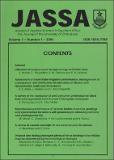| dc.contributor.author | Mudambo, K.S.M.T. | |
| dc.contributor.author | Zivawose, C.J. | |
| dc.contributor.author | Mandisodza, A.R. | |
| dc.contributor.author | Dzuda, C. | |
| dc.contributor.author | Cakana, A.Z. | |
| dc.contributor.author | Siziya, S. | |
| dc.contributor.author | Tafirenyika, A. | |
| dc.contributor.author | Tandayi, M. | |
| dc.contributor.author | Zenda, E. | |
| dc.coverage.spatial | Zimbabwe. | en |
| dc.date.accessioned | 2016-03-08T12:00:58Z | |
| dc.date.available | 2016-03-08T12:00:58Z | |
| dc.date.issued | 2001 | |
| dc.identifier.citation | Mudambo, K.S.M.T. et al., (2001) Dropout rate during prolonged physical stress training in the military may be determined by haematological changes, Journal of Applied Science in Southern Africa (JASSA), vol. 7, no.1, pp. 61-71. Harare: UZ Publications. | en |
| dc.identifier.issn | 1019-7788 | |
| dc.identifier.uri | https://opendocs.ids.ac.uk/opendocs/handle/20.500.12413/9790 | |
| dc.description | A public health research paper on sustained physical training in the military leading to high drop-out rates amongst new recruits in the Zimbabwe National Army. | en |
| dc.description.abstract | Sustained physical training has profound effects on haematological adaptive changes and these may influence physical performance, the dropout rates and casualties in a military setting. Prompted by reports of increases in the number of dropouts during military training, the impact of haematological changes on dropout rates and physical performance was studied in 60 male Zimbabwe National Army (ZNA) recruits during 60 days of military training at the Nyanga training camp.
The training programme included, among other things, bush exercises in the rugged terrain of the Nyangani range of mountains. Blood for full blood count (FBC) were collected by venepuncture in a forearm vein in a seated position two weeks pre-training (day zero). Subsequent samples were collected at seven, 30 and 60 days. FBC analyses was carried out by Sysmex K800 (Kobe, Japan) and urine samples were analyzed for urobilinogen. The results showed significant decreases in the red blood cells (RBC) and haemoglobin (Hb) (P<0.05) and (P<0.04) on day seven and day 30 respectively when compared to day zero. The persistent increase in haematocrit throughout the 60 days suggested haemoconcentration and a fall in plasma volume (PV). When compared to pre-training, granulocytes were significantly higher on day 60 than on day 30 (P<0.004). Lymphocytes and eosinophils were lower on day seven (P<0.001) when compared to day zero and (P<0.04) and (P<0.013) when compared to day 30 and 60 respectively, suggesting that the subjects had a decreased protection against infection. However, lymphocytes were higher on day 60 than on day seven (P<0.01). This observed recovery in lymphocytes on day 60 when compared to day seven and 30, suggested that acclimatization and adaptation had occurred. Of the 60 subjects, 18 percent were hospitalized [four with pulmonary TB and a hypochromasia blood picture while three had bronchopneumonia and a raised neutrophil count]. The number of dropouts was 16 (27 percent) of the 60 subjects under study. Laboratory observations showed proteinuria, a shift to the left in the myeloid series, nucleated red blood cells, platelet clumps, macrocytosis and red cell fragments. These were associated with casualties, dropouts and poor physical performance. These results suggested that severe haematological changes might be associated with poor performance, high rates of casualties and dropouts. Therefore, monitoring the trends of haematological changes at regular intervals during stress training can minimize casualties and the rates of dropouts. | en |
| dc.publisher | University of Zimbabwe (UZ) Publications | en |
| dc.rights.uri | http://creativecommons.org/licenses/by-nc-nd/3.0/ | en |
| dc.subject | Health | en |
| dc.title | Dropout rate during prolonged physical stress training in the military may be determined by haematological changes | en |
| dc.type | Article | en |
| dc.rights.holder | University of Zimbabwe (UZ) | en |


